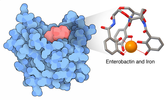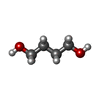Entry Database : PDB / ID : 3k65Title Crystal Structure of Prethombin-2/Fragment-2 Complex (Prothrombin) x 2 Keywords / / / Function / homology Function Domain/homology Component
/ / / / / / / / / / / / / / / / / / / / / / / / / / / / / / / / / / / / / / / / / / / / / / / / / / / / / / / / / / / / / / / / / / / / / / / / / / / / / / / / / / / / / / / / / / / / / / / / / / / / / / / / / / / / / / / / / / / Biological species Homo sapiens (human)Method / / / / Resolution : 1.85 Å Authors Adams, T.E. / Huntington, J.A. Journal : Biochimie / Year : 2016Title : Structural transitions during prothrombin activation: On the importance of fragment 2.Authors : Adams, T.E. / Huntington, J.A. History Deposition Oct 8, 2009 Deposition site / Processing site Revision 1.0 Sep 29, 2010 Provider / Type Revision 1.1 Jul 13, 2011 Group Revision 1.2 Sep 25, 2013 Group Revision 1.3 Jul 5, 2017 Group / Category / citation_authorItem _citation.journal_abbrev / _citation.journal_id_CSD ... _citation.journal_abbrev / _citation.journal_id_CSD / _citation.journal_id_ISSN / _citation.journal_volume / _citation.page_first / _citation.page_last / _citation.pdbx_database_id_DOI / _citation.pdbx_database_id_PubMed / _citation.title / _citation.year Revision 1.4 Oct 13, 2021 Group / Derived calculations / Category / struct_ref_seq_dif / struct_siteItem _database_2.pdbx_DOI / _database_2.pdbx_database_accession ... _database_2.pdbx_DOI / _database_2.pdbx_database_accession / _struct_ref_seq_dif.details / _struct_site.pdbx_auth_asym_id / _struct_site.pdbx_auth_comp_id / _struct_site.pdbx_auth_seq_id Revision 1.5 Sep 6, 2023 Group / Refinement descriptionCategory / chem_comp_bond / pdbx_initial_refinement_modelRevision 1.6 Nov 27, 2024 Group / Category / pdbx_modification_feature
Show all Show less
 Open data
Open data Basic information
Basic information Components
Components Keywords
Keywords Function and homology information
Function and homology information Homo sapiens (human)
Homo sapiens (human) X-RAY DIFFRACTION /
X-RAY DIFFRACTION /  SYNCHROTRON /
SYNCHROTRON /  MOLECULAR REPLACEMENT /
MOLECULAR REPLACEMENT /  molecular replacement / Resolution: 1.85 Å
molecular replacement / Resolution: 1.85 Å  Authors
Authors Citation
Citation Journal: Biochimie / Year: 2016
Journal: Biochimie / Year: 2016 Structure visualization
Structure visualization Molmil
Molmil Jmol/JSmol
Jmol/JSmol Downloads & links
Downloads & links Download
Download 3k65.cif.gz
3k65.cif.gz PDBx/mmCIF format
PDBx/mmCIF format pdb3k65.ent.gz
pdb3k65.ent.gz PDB format
PDB format 3k65.json.gz
3k65.json.gz PDBx/mmJSON format
PDBx/mmJSON format Other downloads
Other downloads 3k65_validation.pdf.gz
3k65_validation.pdf.gz wwPDB validaton report
wwPDB validaton report 3k65_full_validation.pdf.gz
3k65_full_validation.pdf.gz 3k65_validation.xml.gz
3k65_validation.xml.gz 3k65_validation.cif.gz
3k65_validation.cif.gz https://data.pdbj.org/pub/pdb/validation_reports/k6/3k65
https://data.pdbj.org/pub/pdb/validation_reports/k6/3k65 ftp://data.pdbj.org/pub/pdb/validation_reports/k6/3k65
ftp://data.pdbj.org/pub/pdb/validation_reports/k6/3k65 Links
Links Assembly
Assembly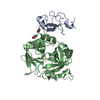
 Components
Components Homo sapiens (human) / References: UniProt: P00734, thrombin
Homo sapiens (human) / References: UniProt: P00734, thrombin Homo sapiens (human) / Gene: F2 / Plasmid: pET23preII(S195A) / Production host:
Homo sapiens (human) / Gene: F2 / Plasmid: pET23preII(S195A) / Production host: 
 X-RAY DIFFRACTION / Number of used crystals: 1
X-RAY DIFFRACTION / Number of used crystals: 1  Sample preparation
Sample preparation SYNCHROTRON / Site:
SYNCHROTRON / Site:  Diamond
Diamond  / Beamline: I04 / Wavelength: 0.97 Å
/ Beamline: I04 / Wavelength: 0.97 Å molecular replacement
molecular replacement Processing
Processing MOLECULAR REPLACEMENT
MOLECULAR REPLACEMENT Movie
Movie Controller
Controller



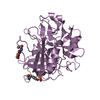
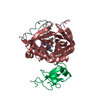
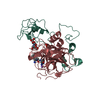

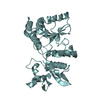

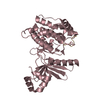
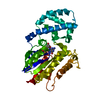
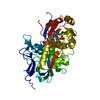

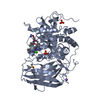

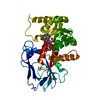
 PDBj
PDBj



